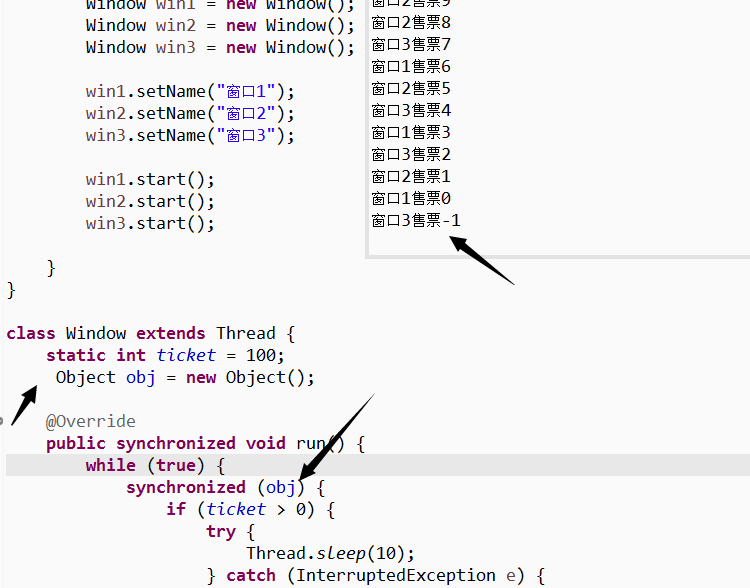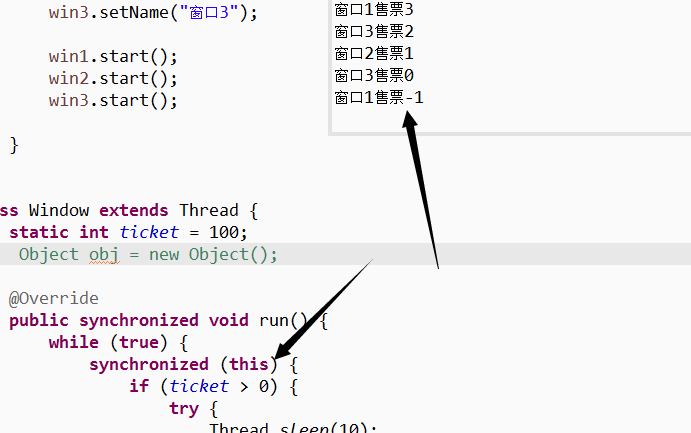版权声明: https://blog.csdn.net/m0_37682436/article/details/80661426
synchronized关键字
实现Runnable接口,加锁可以用
Object obj = new Object();
this
lock
因为操作的是同一个对象 win1
package com.thread;
import java.util.concurrent.locks.Lock;
import java.util.concurrent.locks.ReentrantLock;
public class Thick1 {
public static void main(String[] args) {
Window1 win1 = new Window1();
Thread t1 = new Thread(win1);
Thread t3 = new Thread(win1);
Thread t2 = new Thread(win1);
t1.setName("窗口1");
t2.setName("窗口2");
t3.setName("窗口3");
t1.start();
t2.start();
t3.start();
}
}
class Window1 implements Runnable {
private static int ticket = 100;
// 创建锁对象
Object obj = new Object();
@Override
public void run() {
while (true) {
synchronized (obj) {
if (ticket > 0) {
try {
Thread.sleep(10);
} catch (InterruptedException e) {
e.printStackTrace();
}
System.out.println(Thread.currentThread().getName() + "售票: " + ticket--);
} else {
break;
}
}
}
}
}
private Lock lock = new ReentrantLock();
虽然我们可以理解同步代码块和同步方法的锁对象问题,但是我们并没有直接看到在哪里加上了锁,在哪里释放了锁, 为了更清晰的表达如何加锁和释放锁,JDK5以后提供了一个新的锁对象Lock
Lock:
void lock():获取锁
void unlock():释放锁
ReentrantLock是Lock的实现类
package com.thread;
import java.util.concurrent.locks.Lock;
import java.util.concurrent.locks.ReentrantLock;
class SellTicket implements Runnable {
private int tickets = 100;
// 定义锁对象
private Lock lock = new ReentrantLock();
@Override
public void run() {
while (true) {
try {
// 加锁
lock.lock();
if (tickets > 0) {
try {
Thread.sleep(100);
} catch (InterruptedException e) {
e.printStackTrace();
}
System.out.println(Thread.currentThread().getName() + "正在出售第" + (tickets--) + "张票");
}
} finally {
// 释放锁
lock.unlock();
}
}
}
}
/*
* 虽然我们可以理解同步代码块和同步方法的锁对象问题,但是我们并没有直接看到在哪里加上了锁,在哪里释放了锁,
* 为了更清晰的表达如何加锁和释放锁,JDK5以后提供了一个新的锁对象Lock
*
* Lock: void lock():获取锁 void unlock():释放锁 ReentrantLock是Lock的实现类
*/
public class SellTicketDemo {
public static void main(String[] args) {
// 创建资源对象
SellTicket st = new SellTicket();
// 创建三个窗口
Thread t1 = new Thread(st, "窗口1");
Thread t2 = new Thread(st, "窗口2");
Thread t3 = new Thread(st, "窗口3");
// 启动线程
t1.start();
t2.start();
t3.start();
}
}
继承Thread类实现加锁,不适用于this,因为是三个对象,可以在Object obj = new Object(); 前面加上static,
package com.thread;
public class Ticket {
public static void main(String[] args) {
Window win1 = new Window();
Window win2 = new Window();
Window win3 = new Window();
win1.setName("窗口1");
win2.setName("窗口2");
win3.setName("窗口3");
win1.start();
win2.start();
win3.start();
}
}
class Window extends Thread {
static int ticket = 100;
static Object obj = new Object();
@Override
public synchronized void run() {
while (true) {
synchronized (obj) {
if (ticket > 0) {
try {
Thread.sleep(10);
} catch (InterruptedException e) {
e.printStackTrace();
}
System.out.println(Thread.currentThread().getName() + "售票" + ticket--);
} else {
break;
}
}
}
}
}$$$$$$$$$$$$$$$$$$$$$$$$$$$$$$$$$$$$$$$$$$$$$$$$$$$$$$$$

